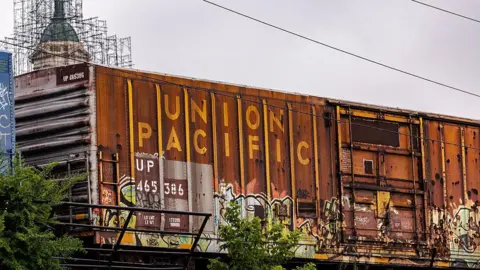The proposed merger of two significant American freight railroad companies, Union Pacific and Norfolk Southern, is poised to revolutionize freight transport in the United States by creating the first coast-to-coast rail network. Valued at an impressive $85 billion (£63.8 billion), this groundbreaking deal is set to establish a formidable company with an overarching network that connects 100 ports and spans 50,000 miles across 43 states.
Union Pacific’s decision to purchase its smaller East Coast rival, Norfolk Southern, signals a monumental shift in the rail industry. Executives have expressed optimism that the merger will enhance shipping efficiency and bolster the competitive position of rail transport against other logistics modes such as trucking and aviation. This anticipated increase in efficiency arises from the potential streamlining of operations, which could result in reduced transit times for freight transportation—a key objective in an industry marred by congestion and service delays.
Despite the promising prospects of the merger, concerns linger among stakeholders, including customers and labor unions. Critics worry about possible job losses, hikes in transportation prices, and potential disruptions in service during the consolidation of the two companies. Union Pacific’s chief executive, Jim Vena, acknowledged these challenges, asserting that the firm is well-prepared to address any issues that might emerge during the merger process.
The regulatory landscape for mergers and acquisitions has been under scrutiny, particularly under different presidential administrations. The Biden administration has taken a cautious stance towards large-scale mergers, while some expectations suggest that a Trump administration might foster a more lenient regulatory framework. Vena’s confidence in the approval of the deal shows a proactive approach, as he reassured analysts that the company had considered the implications and is ready to tackle any forthcoming concerns.
Once the merger is executed, the newly formed entity, to be named Union Pacific Transcontinental Railroad, will be headquartered in Omaha, Nebraska—a strategic location that positions it at the heart of the US logistics network. Union Pacific, with origins tracing back to the Civil War, is well-established in the western region of the country, while Norfolk Southern primarily serves the east. The convergence of these two titans holds promise for cutting a day or more off transit times for freight moving nationwide.
In essence, this merger is framed not merely as an expansion but as an operational enhancement. Norfolk Southern’s chief financial officer, Jason Zampi, emphasized that the integration is about becoming a more efficient railroad rather than just a larger one. By optimizing operations and reducing the number of cars needed to transport similar volumes of goods, the merger aims to alleviate the congestion that frequently plagues existing rail networks.
The companies have set an ambitious timeline to complete the merger by early 2027, planning to allocate around $2 billion towards aligning their networks effectively. Vena’s assurance to employees underscores the intent to preserve existing union jobs amidst the changes—indicating a commitment to workforce stability even during a significant transformation.
Investors in Norfolk Southern stand to benefit considerably from the merger, receiving an estimated $88.82 per share alongside a stake in the new conglomerate. This figure represents a substantial appreciation of roughly 25% over the share prices observed prior to speculation of the merger.
Although rail traversing from coast to coast has been operational since the completion of the transcontinental railroad in 1869, freight movement has historically entailed cooperation among various railway companies. The merger of Union Pacific and Norfolk Southern will redefine the paradigm of freight transport in America, providing a single, unified entity capable of servicing the vast logistical needs of the country more seamlessly.
Additionally, the landscape of passenger rail in the U.S., dominated by companies like Amtrak, is influenced by the tracks and schedules dictated by freight operators. This merger may, therefore, have broader implications not only for freight transport but also for passenger services that rely on the efficient functioning of these rail routes.
In summary, the anticipated merger of Union Pacific and Norfolk Southern encapsulates a landmark development in the U.S. rail industry that could redefine freight logistics as we know it. The potential for enhanced efficiency and connectivity promises to benefit both customers and investors while posing challenges that the newly formed entity must navigate adeptly.











